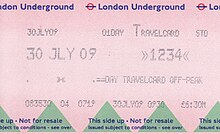
The history of public transport authorities in London details the various organisations that have been responsible for the public transport network in and around London, England - including buses, coaches, trams, trolleybuses, Docklands Light Railway, and the London Underground.
National Rail (NR) is the trading name licensed for use by the Rail Delivery Group, an unincorporated association whose membership consists of the passenger train operating companies (TOCs) of England, Scotland, and Wales. The TOCs run the passenger services previously provided by the British Railways Board, from 1965 using the brand name British Rail. Northern Ireland, which is bordered by the Republic of Ireland, has a different system. National Rail services share a ticketing structure and inter-availability that generally do not extend to services which were not part of British Rail.

Transport for London (TfL) is a local government body responsible for most of the transport network in London, United Kingdom.
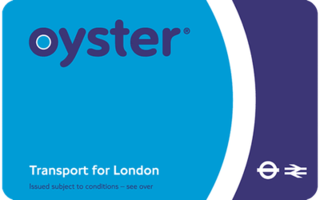
The Oyster card is a payment method for public transport in London in England, United Kingdom. A standard Oyster card is a blue credit-card-sized stored-value contactless smart card. It is promoted by Transport for London (TfL) and can be used on travel modes across London including London Buses, London Underground, the Docklands Light Railway (DLR), London Overground, Tramlink, some river boat services, and most National Rail services within the London fare zones. Since its introduction in June 2003, more than 86 million cards have been used.

Heathrow Terminals 2 & 3 is a London Underground station at Heathrow Airport on the Heathrow branch of the Piccadilly line, which serves Heathrow Terminal 2 and Terminal 3. It was named Heathrow Terminals 1, 2, 3 until January 2016, when Heathrow Terminal 1 was closed. Despite the renaming of the station, the signage on the platform still says Heathrow Terminals 1, 2, 3 as of December 2023. The station is situated in Travelcard Zone 6, along with the nearby Heathrow Terminals 2 & 3 railway station served by Heathrow Express and Elizabeth line services.

London Buses is the subsidiary of Transport for London (TfL) that manages most bus services in London, England. It was formed following the Greater London Authority Act 1999 that transferred control of London Regional Transport (LRT) bus services to TfL, controlled by the Mayor of London.
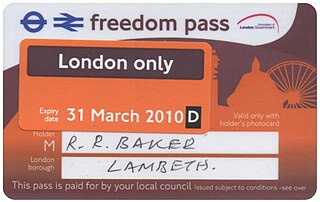
Freedom Pass is a concessionary travel scheme, which began in 1973, to provide free travel to residents of Greater London, England, for people with a disability or over the progressively increasing women's state pension age. The scheme is funded by local authorities and coordinated by London Councils. Originally the pass was a paper ticket, but since 2004 it has been encoded on to a contactless smartcard compatible with Oyster card readers.
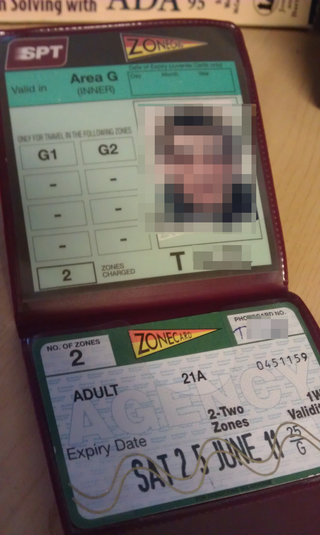
ZoneCard is a travel card issued by the Strathclyde Partnership for Transport, formerly Strathclyde Passenger Transport in Scotland.
The London Underground and Docklands Light Railway (DLR) metro systems of London, England uses a mix of paper and electronic smart-card ticketing.

London has an extensive and developed transport network which includes both public and private services. Journeys made by public transport systems account for 37% of London's journeys while private services accounted for 36% of journeys, walking 24% and cycling 2%,according to numbers from 2017. London's public transport network serves as the central hub for the United Kingdom in rail, air and road transport.
There is no single 'discount railcard' available on the UK railway network. In addition to the large number and variety of short-term or localised promotional fares that have been available to passengers on the British railway network in recent decades, there are many permanent concessionary fare schemes available to passengers. Some of these take the form of Railcards, which can be purchased by people who qualify according to the conditions, and which give discounts for all journeys over a period; other concessions are available for individual journeys. In all cases, details of the type of concession will be printed on the passenger's travel ticket, to distinguish reduced-rate tickets from those sold at the standard full fare.

The 16–25 Railcard is an annual card giving discounts on certain types of railway ticket in Britain. It is available to anybody aged between 16 and 25 (inclusive), and certain mature students aged 26 and above, and is currently priced at £30.00. There is no restriction on the number of times the Railcard can be used to purchase discounted tickets during the period of its validity, and there are no geographical restrictions on its use.

get me there is an electronic ticketing scheme under development by Transport for Greater Manchester (TfGM) for use on public transport services in Greater Manchester, England. It was first announced and confirmed as an integrated travel card, comparable to London's Oyster card, for Greater Manchester in June 2012, following a bid from the Greater Manchester Combined Authority.

A transit pass or travel card, often referred to as a bus pass or train pass etc., is a ticket that allows a passenger of the service to take either a certain number of pre-purchased trips or unlimited trips within a fixed period of time.
The London Transport Executive was the executive agency within the Greater London Council, responsible for public transport in Greater London from 1970 to 1984. In common with all London transport authorities from 1933 to 2000, the public name and operational brand of the organisation was London Transport.

Rail service fares in Greater London and the surrounding area are calculated in accordance with the London fare zones system managed by Transport for London. Within London, all London Underground, National Rail, London Overground, Elizabeth Line and Docklands Light Railway stations are assigned to six fare zones. Fare zone 1 covers the central area and fare zones 2, 3, 4, 5 and 6 form concentric rings around it. Some National Rail stations and almost all Transport for London served stations outside Greater London in the home counties of Buckinghamshire, Essex, Hertfordshire and Surrey are either included in fare zones 4, 5 or 6 or in extended zones beyond these. Transport for London fare zones are also known simply as zones or travelcard zones, referring to their use in calculating prices for the travelcards or pay-as-you-go caps. Before flat fares were introduced in 2004, fare zones were used on the London Buses network. London fare zones are also used for calculating the cost of single and return paper tickets, Oyster card pay-as-you-go fares and season tickets.

Contactless smartcards are being progressively introduced as an alternative option to paper ticketing on the National Rail system of Great Britain. Tickets for use on National Rail services can be loaded onto any ITSO card.

Plusbus is an add-on ticket, which can be purchased with National Rail train tickets in the United Kingdom. It allows unlimited travel on participating bus and tram operators' services in the whole urban area of rail-served towns and cities.
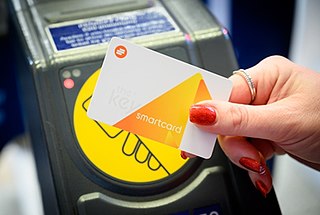
The Key is a contactless ITSO-compatible smartcard developed by the Go-Ahead Group used on buses, trains and other forms of public transport across various areas of the United Kingdom.
